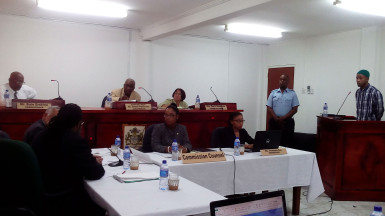Inmate Michael Lewis yesterday said prison officials had ample opportunity to rescue prisoners from the March 3rd fatal fire, in which 17 of his fellow inmates died.
He was at the time testifying before the Commission of Inquiry into the prisoner deaths at the Department of Public Service building in Georgetown.
Lewis, a murder accused, stated that the hole in the wall that the prisoners had made after the doors to Capital A Block of the Capital Division building were shut, could have allowed the prison authorities access to the dormitory.
The hole, which he stated was approximately 5ft by 3ft on the day of the tragedy, separates the Capital A Block, where the fire reportedly began, from the adjoining B Block.
It was through this hole, Lewis alleged, officers had first extinguished the fire. It is also through this hole, he claimed, that two cans of tear gas were thrown into the block by an officer dressed in riot gear and a face mask.
Lewis could not give a description of the height of this officer as he said his vantage point and the size of the hole prevented him from seeing him fully. He did, however, state that the individual, who was there with at least one other officer, appeared to be “thin-boned.”
The inmate testified that after the tear gas was thrown into the dorm, those at the door began shouting to be let out.
Lewis, along with 12 other inmates, made their way to the back of the room near a door, located approximately three feet from his bed. This door is where they were able to get ventilation in the smoke-filled room.
“I run from the hole. The heat was burning me. I run to the bathroom and I could have feel two body already in the bathroom… my breath was cutting, so I hustle back [to the door], an Amerindian chap was already there—I had to pull he back just to get my space,” he said.
He related that during that time no officers had come. He estimates that he was trapped in the dorm for close to two hours.
Trapped

Recounting his experience of being trapped in the fire, the 39-year-old inmate began crying on the stand. He recalled that a fellow inmate, Rayon Paddy, who later succumbed, had been laying two feet from him. He said that as he lay on the floor that day, he prayed to “Allah… the Almighty” to open the door.
Help eventually came through a prisoner he identified as Steve Bacchus. Bacchus, he said, ran down the catwalk, which surrounds the Capital Block, and told the group of inmates lying near the door not to panic. He related that Bacchus first attempted to break the door open with a sledge hammer, but when this did not work, he left, and returned with a fireman and a warden. The warden, whom he identified as “Mr. Crawford,” tried opening the door but the keys did not work. Bacchus eventually returned and told them the door to the block had been opened, leading to them making their escape. He said when he walked out the door that day, there were already two dead bodies lying on the catwalk.
Lewis testified that there was a difference in the conduct of the prison officials on the morning of March 3rd. One such difference, he noted, was that an officer had been videoing the events, which registered as peculiar to him, having been subject to several searches during his more than two years being at the prison. Similar evidence was given by another inmate, Basil Morgan, on Monday.
Lewis also stated that on that same morning, when the officers had come to escort them out for another search, they had not fed any of the inmates from the Capital Block. He explained that food is usually brought to the block between the hours of 7am and 9am.
Furthermore, during the week of the fire, Lewis said that the prison wardens had been practising fire drills, the first of which he had witnessed in his two years at the facility. Lewis stated further that when the time came for the wardens to put their training into practice, they failed at the task.




